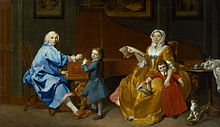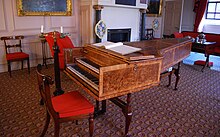Burkhardt Tschudi


Burkhardt Tschudi (born March 13, 1702 in Schwanden GL ; died August 19, 1773 in London ; English: Burkat Shudi ) was a British harpsichord maker of Swiss origin and father-in-law of the founder of the Broadwood & Sons piano factory .
Live and act
Burkhardt Tschudi was born as the son of the wool dealer, surgeon and councilor Josua Tschudi Elmer in the "Farb" in Schwanden. After an apprenticeship as a carpenter, he went on a journey at the age of sixteen and found a job in London with the leading harpsichord maker Hermann Tabel .
Tschudi acquired many of his master's techniques and during the 1720s he made it into English society thanks to two special sponsors: Johann Jacob Heidegger , director of the opera house, and Georg Friedrich Handel , director of the royal music academy under King George since 1719 I . Handel often visited Tschudi, who set up his own business in the Soho district from 1728 and anglicized his name in Burkat Shudi , and also put him in contact with the Italian singer Anna Maria Strada, who he played with a harpsichord with the signature “Burckart Tschudi, Londini, fecit 1729 “Built. In the same year, thanks to Handel's intercession, Shudi was also able to deliver a harpsichord to the Prince of Wales and therefore used the "Plume of Feathers" as a company sign and called himself the harpsichord maker to his Royal Highness the Prince of Wales as the purveyor to the court .
In 1728 he married Katharina Wild (1707–1758), who had emigrated with her parents from Schwanden to London before Tschudi, and they started the business with her dowry. He had eleven children with her. In 1759 Shudi married for the second time and had another daughter, Elizabeth Meyer, from Switzerland. After the premises at No. Meards Street 1 became too small, Shudi moved the workshop to No. Great Pulteney Street in 1739 . 32. Since other London instrument makers and musicians also settled in this part of the city, for example the Alsatian Jacob Kirkman, who had married the Tabel widow, and the violinist John Clegg, according to a statement by the violinist Michael Christian Festing, “the quarter under the string vibrations vibrates ".
Shudi was able to win two important employees. Johann Christoph Zumpe (1735–1800) was Gottfried Silbermann's apprentice and emigrated to England in the 1750s. There he worked for Shudi before starting his own business in 1761 under the sign of the "Golden Guittar" in Hanover Square. John Broadwood worked for Shudi since 1761 and married Shudi's youngest daughter Barbara on January 2, 1769 (* 1749 - July 8, 1776).
Shudi's real achievement was the invention of the "Venetian swell", which was introduced shortly afterwards as " swell " in organ building, with which the volume of the game could be influenced via a pedal system. "Here a whole system of parallel blinds opens over the strings, which are slowly opened and closed by the pedal, which strengthens and weakens the tone." In 1764 Shudi built a harpsichord for the Prussian King Friedrich II , which the members of the Mozart family in London tried out in advance. Broadwood and Shudi had built sills and dampers with pedals into the instrument for the first time ; a type of mechanics that was progressive at the time, with which the pianist could better regulate loud and quiet playing. Friedrich II owned several Tschudi harpsichords.
Son Burkhat (1738-1803) and daughter Barbara with husband John Broadwood took over the management on March 7, 1771, from 1782 Broadwood was sole managing director. With the death of the company founder in 1773, the company passed to Burkhat, Barbara and John. In 1771 Broadwood made his first square piano based on the model of Johannes Zumpe. While Shudi and Broadwood made fourteen harpsichords a year in the early 1770s, Broadwood increased production tenfold by 1784. Broadwood then shifted production to the piano and stopped making harpsichords in the mid-1790s. Tschudi's grandson, James Shudi Broadwood, still bore the name Tschudi.
Both Mozart and Joseph Haydn , who frequented the Tschudi family in London, played Shudi Broadwood instruments. Another Shudi instrument was shipped to the British Consul Joseph Smith in Venice . His widow Elizabeth took the instrument back to Bath with her in 1778 , and after her death, "a harmonious harpsichord with two keyboards by Shudi with pedals" was auctioned on April 9, 1789 at Christie's in London.
23 Tschudi harpsichords can still be identified today. One of them is in Tschudi's homeland, in the Freuler Palace in Näfels . A two-manual instrument, built in 1766 and a gift to the Prussian King Friedrich II., Is located in the lower concert room (room number 161) of the Lower Princely Quarter in the north wing of the New Palace in Potsdam .
literature
- William Dale: Tschudi: The Harpsichord Maker. Constable and Comp., London 1913 ( digitized and text )
- Hagen W. Lippe-Weißenfeld: The piano as a means of socio-political distinction. Cultural sociological case study on the development of the piano manufacturing industry in England and Germany using the examples of Broadwood and Bechstein. Lang, Frankfurt am Main [a. a.] 2007, ISBN 978-3-631-56268-0 . Digitized
- Oscar Bie: The piano and its masters. Munich 1901. Digitized
Web links
- Christoph Ballmer: Burkhardt Tschudi. In: Historical Lexicon of Switzerland .
Individual evidence
- ↑ It is not clear from the description of the picture whether it is the harpsichord from Tschudi's manufacture that Frederick bought in 1729.
- ^ History of Schwanden Archive link ( Memento of the original from February 5, 2005 in the Internet Archive ) Info: The archive link was automatically inserted and not yet checked. Please check the original and archive link according to the instructions and then remove this notice.
- ↑ Biographical information on Tschudi near Lippe-Weißenfeld, p. 116 and p. 168f.
- ↑ Oscar Bie: The Piano. P. 111f
- ↑ DRS Tschudi Harpsichord Days 2007 ( page no longer available , search in web archives ) Info: The link was automatically marked as defective. Please check the link according to the instructions and then remove this notice. with Robert Hill and Miklos Spányi.
- ↑ Lippe-Weißenfeld, p. 172
- ↑ Frances Vivian: The Collection of Consul Smith. Masterpieces of Italian drawing from the Royal Library, Windsor Castle. From Raffael to Canaletto. Hirmer, Munich 1989, ISBN 3-7774-5120-7 , p. 39.
- ^ Image in the Deutsche Fotothek , accessed on May 21, 2013 from the picture index .
- ↑ Figure in Historical Musical Instruments and Clocks ( Memento of the original from May 9, 2013 in the Internet Archive ) Info: The archive link was inserted automatically and has not yet been checked. Please check the original and archive link according to the instructions and then remove this notice. on the website of the Prussian Palaces and Gardens Foundation Berlin-Brandenburg , accessed on May 21, 2013.
| personal data | |
|---|---|
| SURNAME | Tschudi, Burkhardt |
| ALTERNATIVE NAMES | Shudi, Burkat |
| BRIEF DESCRIPTION | British harpsichord maker |
| DATE OF BIRTH | March 13, 1702 |
| PLACE OF BIRTH | Schwanden GL |
| DATE OF DEATH | August 19, 1773 |
| Place of death | London |
